To bring some joy into a fraught world, we have rounded up a few of the latest image releases of star mergers and galaxies to brighten your day. Plus, we’ll look at a few strange exoplanetary systems and their amazing science, talk about the latest GOES satellite to launch, and this week in rocket history is all about Envisat.
Podcast
Show Notes
Neutron star merger produces lingering X-ray glow
- CXO press release
- UC Berkeley press release
- “The emergence of a new source of X-rays from the binary neutron star merger GW170817,” A. Hajela et al., to be published in The Astrophysical Journal Letters (preprint on arxiv.org)
Pretty galaxies are full of science
- NOIRLab press release
Hubble spots a triangular galaxy
- ESA Hubble press release
- Hubblesite press release
“Tatooine” planet seen from Earth
- RAS press release
- “BEBOP III. Observations and an independent mass measurement of Kepler-16 (AB) b – the first circumbinary planet detected with radial velocities,” Amaury H M J Triaud et al., 2022 February 25, Monthly Notices of the Royal Astronomical Society
Exploring a hot Jupiter’s atmosphere
- MPIA press release
- “Diurnal variations in the stratosphere of the ultrahot giant exoplanet WASP-121b,” Thomas Mikal-Evans et al., 2022 February 21, Nature Astronomy
ULA launches NOAA satellite
- NOAA press release
- GOES History (NOAA & NASA)
This Week in Rocket History: Envisat
Transcript
What a week, huh?
Beth, it’s Wednesday.
Oh, right.
But we have pretty pictures. Is that enough?
And rockets. Pretty pictures and rockets.
Yup. All of this now, right here on the Daily Space.
I am your host Dr. Pamela Gay.
And I am your host Beth Johnson.
And we’re here to put science in your brain
There are days when all of us just need to look at pretty things, and astronomy is here to say, “We got you.” In this first segment, we’re going to just take in some pretty sights and leave the science behind.
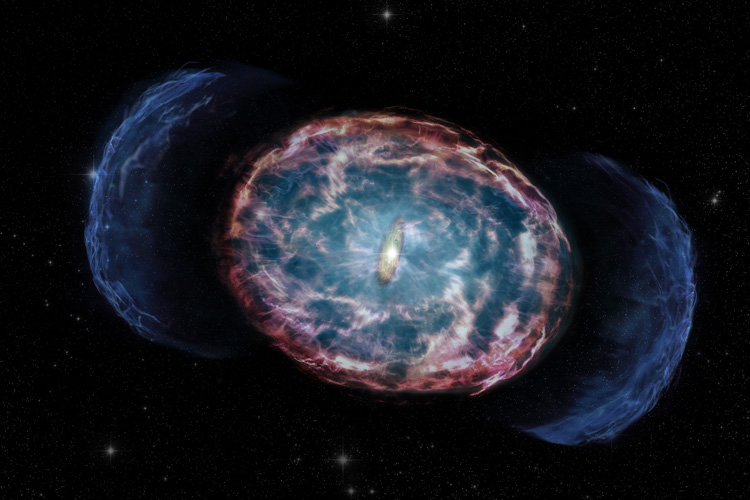
For instance, consider kilonova GW170817. Back in 2017, the light and gravitational waves from two merging neutron stars reached our world, but not everything arrived at exactly the same time. On August 17, gravitational waves were detected by LIGO & Virgo, and high-energy gamma-ray light was detected by Fermi. Researchers quickly turned pretty much any telescope they thought might be useful at this event, and on the list was the Chandra X-ray Observatory. Initially, this telescope saw nothing, but undeterred, Chandra kept returning to that spot in the sky, and on August 26, nine days later, X-ray emission was detected.
And then things got weird. According to a release from Chandra: This non-detection of X-rays quickly followed by a detection provides evidence for a narrow jet of high-energy particles produced by the neutron star merger. The jet is “off-axis” – that is, not pointing directly towards Earth. Researchers think that Chandra originally viewed the narrow jet from its side, and therefore saw no X-rays immediately after the gravitational waves were detected. However, as time passed, the material in the jet slowed down and widened as it slammed into the surrounding material. This caused the cone of the jet to begin to expand more into Chandra’s direct line of sight, and X-ray emission was detected. Since early 2018, the X-ray emission caused by the jet had steadily been getting fainter as the jet further slowed down and expanded. Hajela and her team then noticed that from March 2020 until the end of 2020 the decline stopped and the X-ray emission was approximately constant in brightness.
That last step – the X-Ray emission appearing constant in brightness – is weird and seems to indicate there is something more than just a jet generating this light.
Option 1, which has been turned into some truly amazing artwork that we’ll link to on our website, DailySpace.org, has a shockwave from the merger hitting the surrounding material and superheating it so that it glows in X-rays. This kind of afterglow is something we see with other kinds of gamma-ray bursts and would be the first time we’ve seen an afterglow with a neutron star merger.
Alternatively, we could be seeing light from material falling into the black hole that formed when those neutron stars merged. This would be the final photon screams of material about to fall into the event horizon.
Further observations should be able to sort out which of these options matches reality. For now, these results are published in The Astrophysical Journal Letters in a paper led by Aprajita Hajela, and while the X-ray observations themselves are just a blob, go check out the artist’s rendering. It is truly amazing.
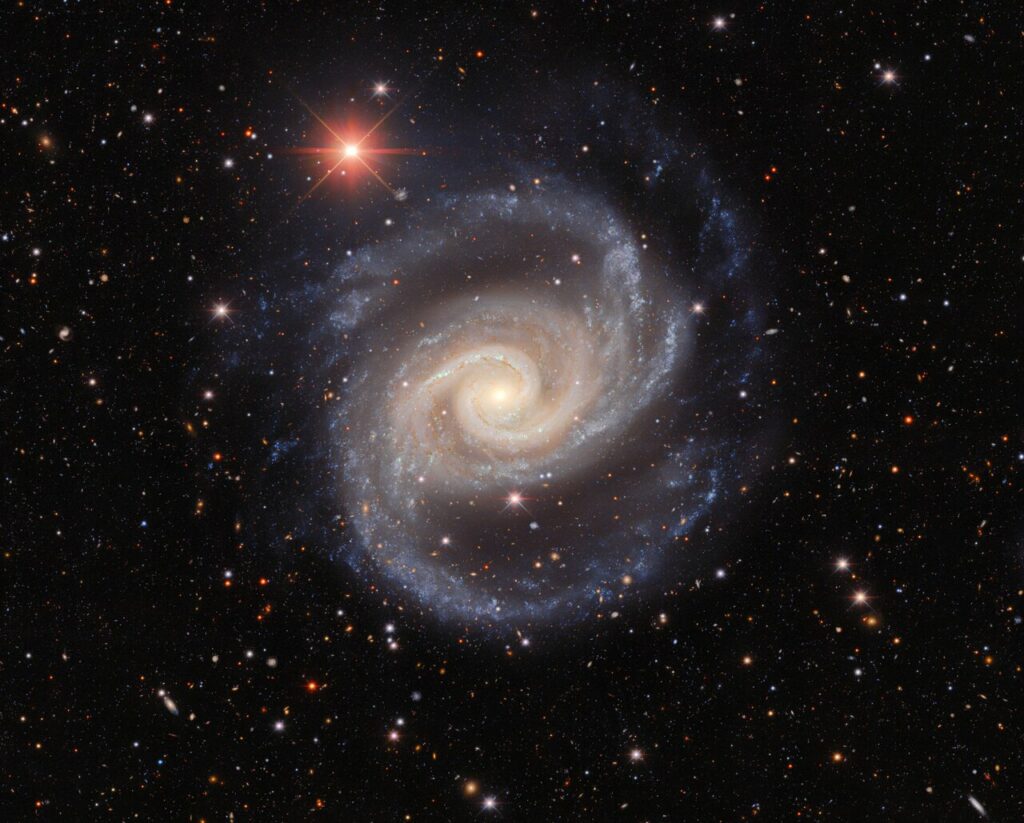
From a prettily illustrated system, we now turn to a beautifully imaged system. Galaxy NGC 1566 is a grand design spiral galaxy that we get to see face-on in the sky. Recently observed with the Cerro Tololo Inter-American Observatory, researchers find in the details of this system the remnants of a 2010 supernova, blue shining star formation regions, and a shining disc around the actively feeding black hole.
This galaxy was imaged as part of the Dark Energy Survey, which has been mapping large areas of the sky in ways that allow distant galaxies to be seen with never-before-imaged details. While the survey imaging ended in 2019, the research discoveries are just beginning.
This particular system is unlikely to bring us any deep insights on dark energy, but since surveys image everything in a region of the sky, they acquire data useful for, well, let’s call it off-label usage, and that’s what this is.
NGC 1566 is the dominant galaxy in a nearby galaxy group called the Dorado group. Its role in that group and its great alignment in the sky make it a great system to use to study what environmental conditions may lead to galaxies looking and acting in different ways, including looking at how its neighbors support NGC 1566’s grand spiral shape.
With galaxies, the question of nature versus nurture comes down heavily on the side of nurture. From NGC 1566’s spiral structure to the gnarly triangular starbursts of Arp 143, interactions between systems shape galaxy after galaxy.
It turns out that if two galaxies of just the right masses line up in just the right ways, you get a grand design spiral. But if things are just wrong, you get what looks like a lightning bug splatting to its death in the sky.
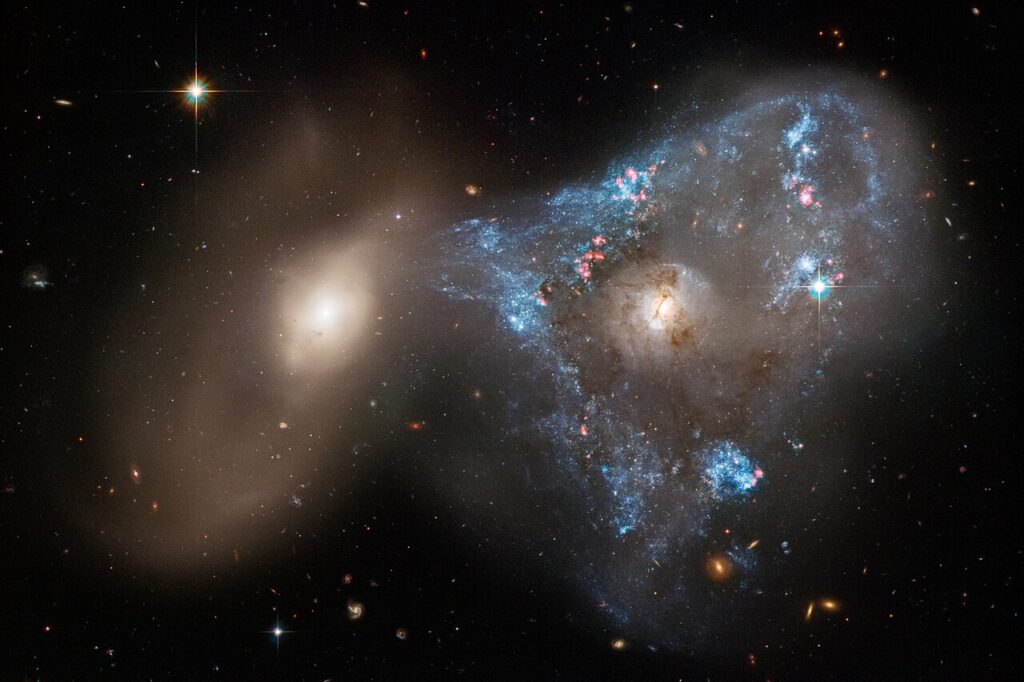
The Arp 143 system consists of two galaxies. One is a blob of reddish light that is distorted through its interactions with its nature. This is NGC 2444. That red color indicates it is dominated by older stars, at least for now.
The other system, consecutively cataloged as NGC 2445, consists of a round core of light surrounded by a massive triangle of star formation. Triangles aren’t a typical shape for galaxies, and in this case, the shape is created by the pull of the red round NGC 2444. It’s thought these systems passed through one another, triggering the star formation and allowing NGC 2444 to pull material with it as it escapes.
Newly released images from the Hubble Space Telescope are allowing researchers to tease out new details in this collision. Specifically, Hubble’s image reveals dark webs of gas and dust blocking light from the star-forming NGC 2445’s core. These structures were formed by outbursts of material and are backlit by stars that have formed in just the past million or so years.
This kind of beautiful destruction is just one step in a multi-billion-year merger process that will eventually bring these two systems together to form one larger galaxy, one likely devoid of new stars. We are witnessing one final gasp of star birth before the system settles into a long red future.
From distant galaxies and all their beauty, let’s now imagine sunsets from other worlds we know exist in our own galaxy. This next pair of stories comes with pretty pictures as well, but instead of images taken by spacecraft, we have artist illustrations. Exoplanets, it turns out, are difficult to take detailed pictures of at this point in time. At best, you get a blocked-out star and a tiny bright dot next to it. Although our telescopes are improving decade by decade, we still have to imagine what these distant worlds might look like.
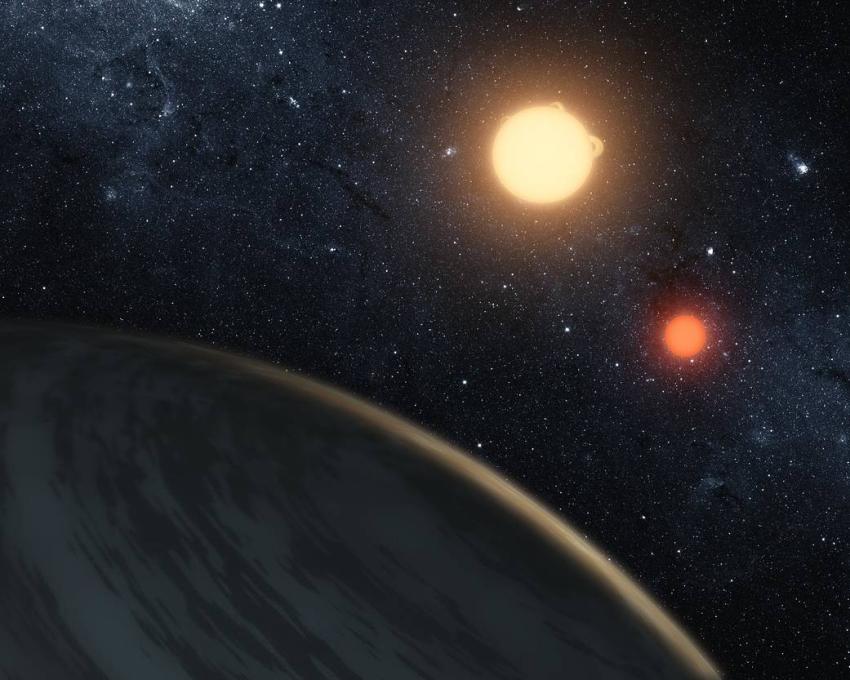
That’s not to say that we cannot detect exoplanets from the ground. While Kepler and TESS use the transit method of finding exoplanets – where they look for dips in the light of a star as a planet passes between the star and the space telescope – ground-based observations can also find and confirm worlds in other star systems. To do this, they use the radial velocity method, where they measure changes in the velocity of a star as an orbiting planet gravitationally tugs on it.
And astronomers using the 193-centimeter telescope at the Observatoire de Haute-Provence in France were able to detect the known exoplanet Kepler-16b. This particular world fascinated everyone when it was discovered ten years ago because it was the first circumbinary exoplanet discovered, proving that a world like Tatooine in Star Wars could and in fact does exist. The team chose this target to prove that their telescope could be used to find exoplanets, as Dr. Isabelle Boisse explains: Our discovery shows how ground-based telescopes remain entirely relevant to modern exoplanet research and can be used for exciting new projects. Having shown we can detect Kepler-16b, we will now analyze data taken on many other binary star systems, and search for new circumbinary planets.
The results of these observations were published in the Monthly Notices of the Royal Astronomical Society.
Good luck to the team in France. May you find many more circumbinary planetary systems.
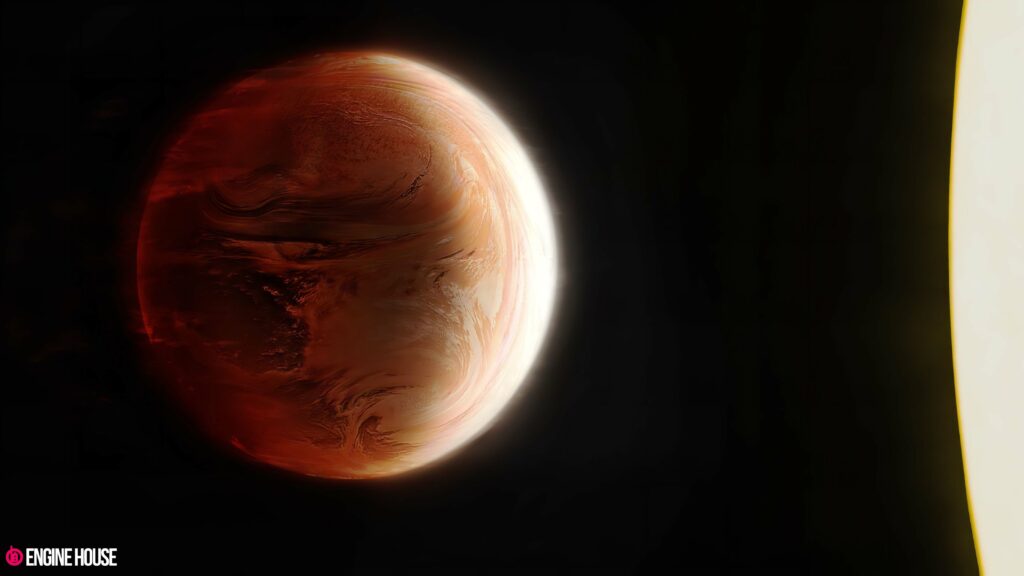
Of course, once you find a planet, you want to learn everything you can about it, and of late, that task has expanded beyond calculating mass and density and turned to understanding distant atmospheres. We’ve talked before about how, while waiting for a certain new telescope to launch and begin actual scientific data collection, researchers have used existing telescopes to peer into exoplanetary clouds. And they’ve done some incredible work with what they had, including getting the most detailed look at the nightside of a tidally locked hot Jupiter.
The planet is WASP-121b. It was discovered in 2015, is about 855 light-years away from our solar system, and has a mass about 20% greater than Jupiter’s mass. It’s also nearly twice as big as Jupiter. Additionally, it’s tidally locked to its star, so the same side always faces the star, and it whips around in a blistering 30-hour orbit. But because we can still get some separation between the planet and the star as it orbits, we can get a glimpse of the dayside before it passes behind.
Now in a new paper published in Nature Astronomy, the researchers published the merged data collected from both hemispheres of WASP-121b and an analysis of the atmosphere as a global system. Co-author David Sing briefly explains: To probe the entire surface of WASP-121 b, we took spectra with Hubble during two complete planet revolutions.
What they found was seriously interesting. WASP-121b upper atmosphere can reach temperatures up to 3000 degrees Celsius on the dayside, which makes the water molecules glow and even break down. On the night side, temps drop to 1500 degrees Celsius, and this gives rise to incredibly strong winds that move those glowing, broken water molecules to the cooler side of the planet. Of course, in cooling the atmosphere, the hydrogen and oxygen can recombine, become water vapor again, and get swept back to the hotter dayside. Lather, rinse and repeat.
But since the water vapor isn’t allowed to form clouds long enough or big enough to rain, what else is in the atmosphere? Metals. Specifically, iron, magnesium, chromium, and vanadium. And those metals can condense into clouds on the night side and possibly cause a rain of liquid gems like rubies and sapphires. No, really. It’s raining gems. Hallelujah?
Next up, the team hopes to get some time on that not-yet-collecting-science-data telescope that I will not name.
And now, we’re going to switch gears and go to Erik Madaus with a rocket launch.

Before we can get to This Week in Rocket History we have to talk about a rocket launch from yesterday. On March 1 at 20:38 UTC, a United Launch Alliance Atlas V 541 launched the GOES-T spacecraft into high perigee geostationary transfer orbit from SLC-41 at Cape Canaveral Space Force Station.
The GOES satellites are operated in geostationary orbit by the National Oceanographic and Atmospheric Administration, or NOAA. NOAA has been operating weather satellites in geostationary orbit since 1974s Synchronous Meteorological Satellite 1. Geostationary orbit allows satellites to image the entire disk of the planet at once, compared to the tens of kilometer wide strip of satellites in low earth orbits. This allows forecasting of weather patterns around the globe.
GOES-T is part of the GOES-R series of satellites and will replace the previous satellite, GOES-S also known as GOES-17. GOES-S had a problem with its primary instrument, the Advanced Baseline Imager (ABI), and needed to be replaced as soon as possible. The ABI on GOES-T and the upcoming GOES-U was fixed before launch. In NOAA tradition, the satellite will not be given a number designation until it’s in orbit and tested. Once GOES-T enters service, it will be known as GOES-18.
And now we go to another remote sensing satellite in This Week In Rocket History.
This Week in Rocket History
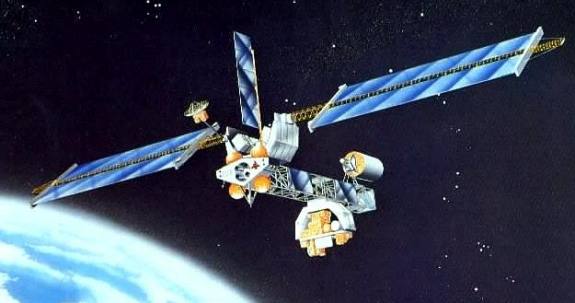
This week in rocket history, we look at one of the biggest remote sensing satellites ever launched — Envisat.
Envisat was an Earth-observing remote sensing satellite built and operated by ESA. Launched in 2002, it was operational until 2012 when it suffered an anomaly that resulted in it going into a safe mode that it was never recovered from. This is its story.
The history of the Envisat satellite starts back in 1990 with a related project called the Polar Platform, an uncrewed remote sensing satellite designed to be visited by ESA’s planned Hermes spaceplane. The goal of Hermes was to give ESA a crewed spaceflight capability. In addition to the goal of visiting the Polar Platform, it was also planned to visit a crewed ESA space station called Columbus and NASA’s Space Station Freedom, which later became the International Space Station (ISS).
Because of budget overruns and the availability of inexpensive Russian space hardware after the fall of the Soviet Union, the Hermes program, including all the various missions, was canceled; however, that wasn’t the end for some components of the Hermes program. The Columbus station became the Columbus module on the ISS, and the instruments from the Polar Platform became two standalone satellites called Envisat and MetOpSat, short for Meteorological Operational Satellite.
The development of Envisat’s payload instruments started in 1993 following the cancellation of the Polar Platform. The design of the satellite bus, optimized to maximize the payload mounting area while being able to fit inside the fairing of an Ariane 5, started in 1995. A total of ten instruments were selected, which accounted for over two metric tons of the eight-metric-ton spacecraft which was 10.5 meters tall, or about as long as a telephone pole, making it the largest European satellite launched at the time.
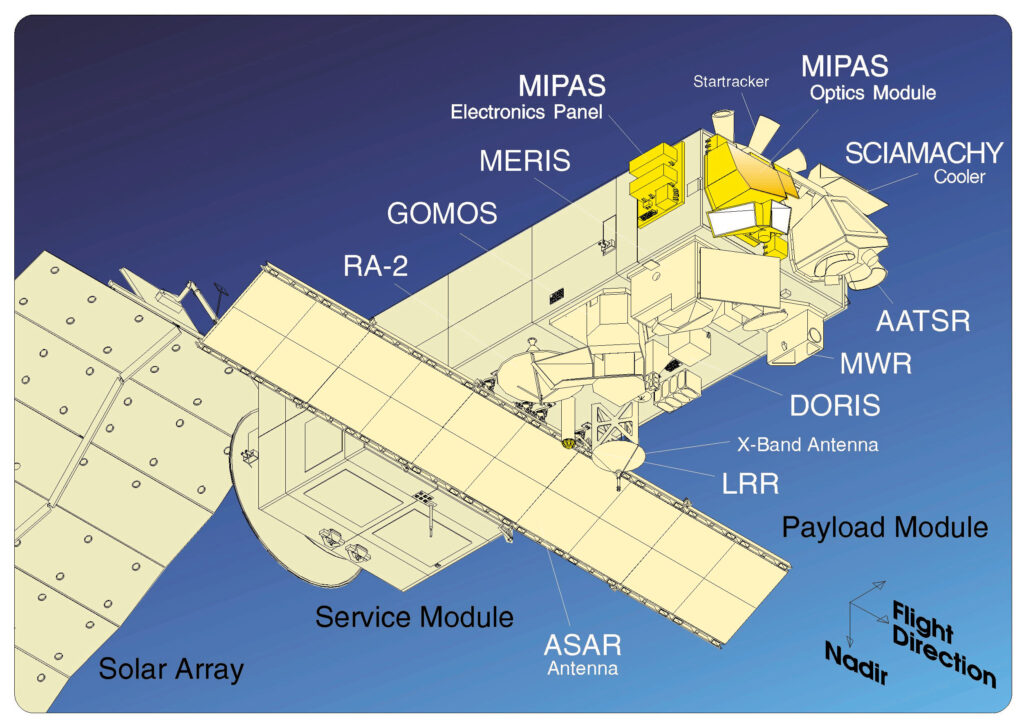
The instruments consisted of two radars, two radiometers, three spectrometers, and an interferometer. In addition to these, there were two instruments designed to make it easier to track the satellite in orbit — the DORIS or Doppler Orbitography and Radiopositioning Integrated by Satellite and a Laser Retro Reflector. As it turned out, these two would end up being very useful.
To save money, Envisat used the same service module – the part that provides power and propulsion – as another remote sensing satellite, SPOT 4. Using a completely independent service module reduced risk in development because the payload module and the service module could be developed and integrated separately and only combined shortly before launch.
Envisat was launched on its planned five-year mission on March 1, 2002, aboard the eleventh Ariane 5 rocket. The launch was successful, which was a relief for everyone because over the course of the previous ten Ariane 5 launches there had been one complete failure and two partial failures, including the launch before Envisat. Despite these initial growing pains, Ariane 5 has gone on to become one of the most reliable rockets in the world, which serves as a reminder that space is hard.
Immediately after launch, the satellite autonomously activated its solar panel release mechanism and pointed towards Earth. It raised its orbit the next day and unfolded its big radar on the fourth day after launch. The payloads were powered up throughout the rest of March and early April 2002. Commissioning of the instruments took place between September and December 2002, with the start of routine operations occurring on January 1, 2003.
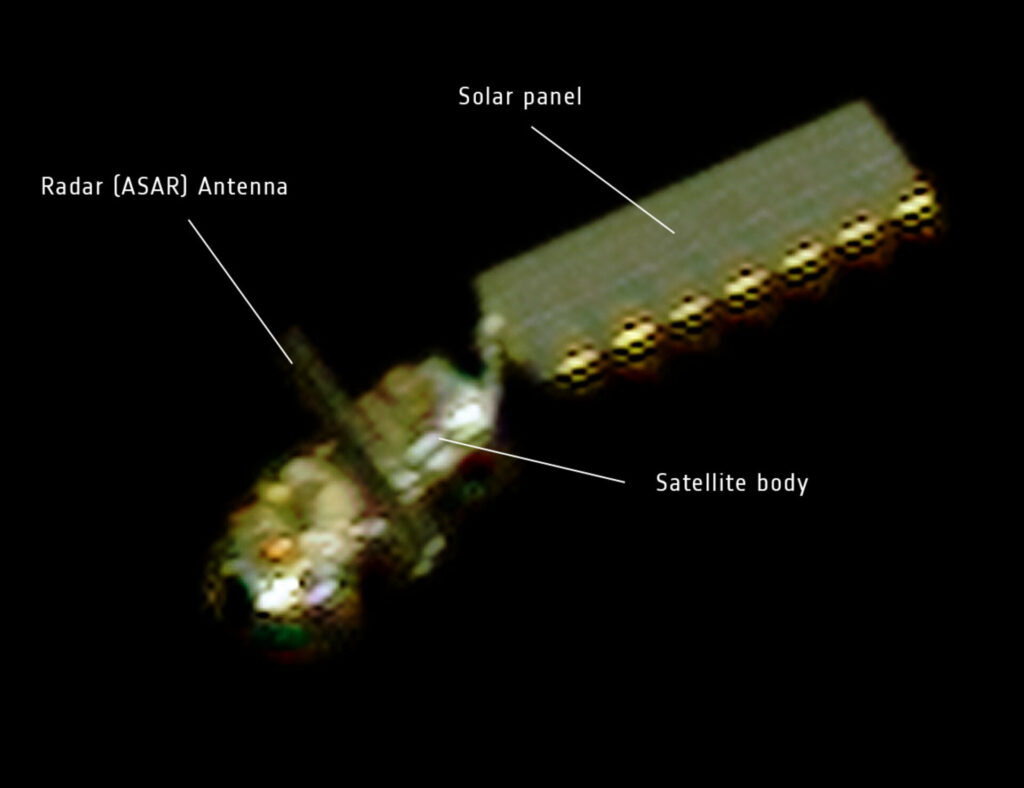
The satellite completed its planned mission in 2009 and was extended through to 2013. However, on April 8, 2012, control of the satellite was lost for no immediately obvious reason.
On April 15, 2012, the high-resolution optical imaging satellite Pléiades took a picture of Envisat to help ground controllers diagnose an external cause to the disruption, but even with this, controllers were unable to determine a cause. One possible reason may have been a short circuit that put the satellite in safe mode, but we’ll probably never know for certain.
Envisat’s mission officially ended on May 9, 2012.
It will take at least 150 years for the spacecraft to decay from its nearly 800-kilometer orbit. A mission called E.Deorbit was planned by ESA to deorbit Envisat, but it was canceled in 2018.
Though it ended, Envisat more than doubled its expected lifespan and delivered ten terabytes of data on the Earth’s land, atmosphere, oceans, and ice caps for disaster and climate change monitoring. It was replaced by the Sentinel series of satellites.
Statistics
And now, for some statistics.
The number of toilets in space is still eight, four on the ISS, one on the Soyuz, one on the Crew Dragon, one on Shenzhou 13, and one on Tianhe.
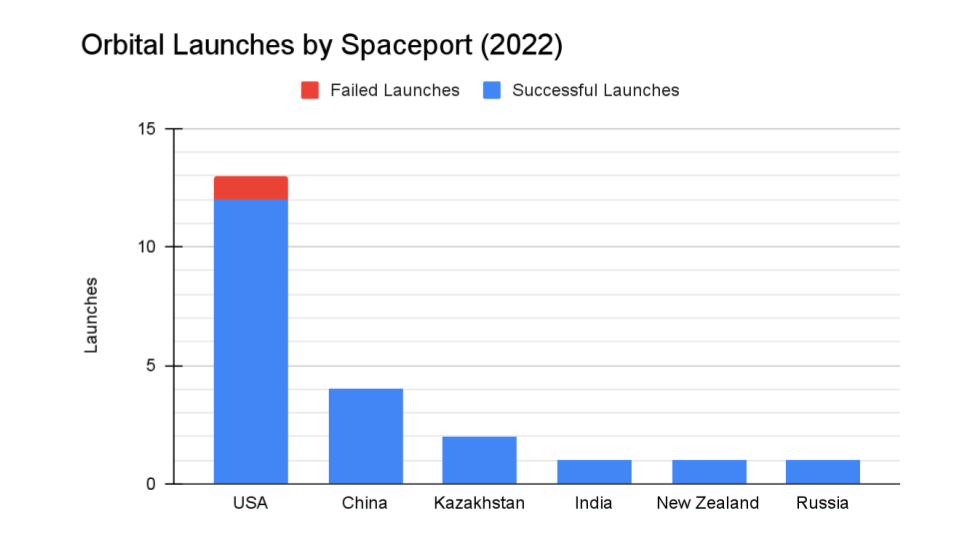
We keep track of orbital launches by launch site, also called spaceport. Here’s that breakdown:
USA 13
China 4
Kazakhstan 2
India 1
New Zealand 1
Russia 1
From those 22 launches, a total of 426 spacecraft were put into orbit.
Your random space fact for this week is that NASA sent two bullfrogs into space to obtain the first direct measurements of the otolith, or inner ear, response during weightlessness. Called the Orbiting Frog Otolith, it was launched on a Scout B rocket from Wallops Island on September 11, 1970. Recovery of the frogs was not planned, and they died in orbit seven days into the mission when the spacecraft’s battery failed.
This has been the Daily Space.
You can find more information on all our stories, including images, at DailySpace.org. As always, we’re here thanks to the donations of people like you. If you like our content, please consider joining our Patreon at Patreon.com/CosmoQuestX.
Credits
Written by Pamela Gay, Beth Johnson, Erik Madaus, and Gordon Dewis
Hosted by Pamela Gay, Beth Johnson, and Erik Madaus
Audio and Video Editing by Ally Pelphrey
Content Editing by Beth Johnson
Intro and Outro music by Kevin MacLeod, https://incompetech.com/music/


 We record most shows live, on Twitch. Follow us today to get alerts when we go live.
We record most shows live, on Twitch. Follow us today to get alerts when we go live.